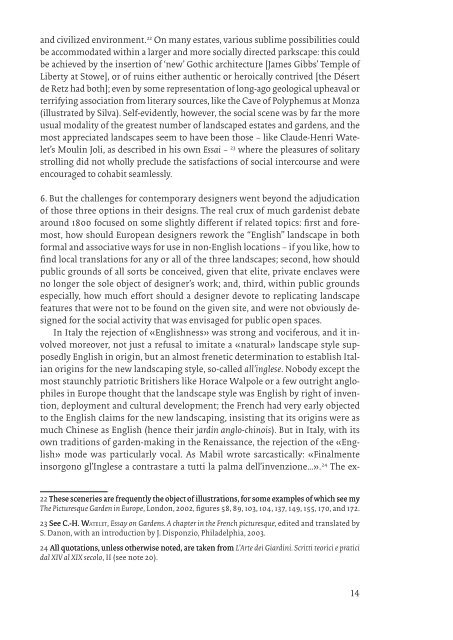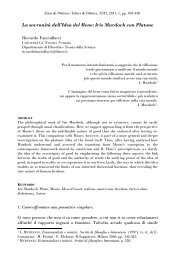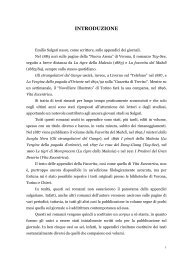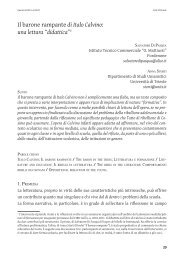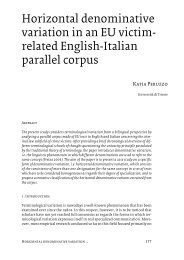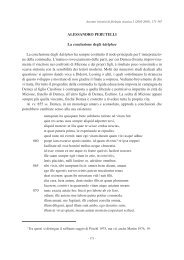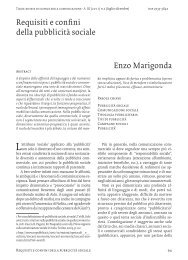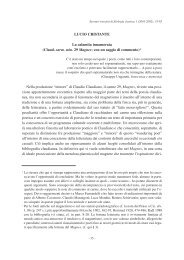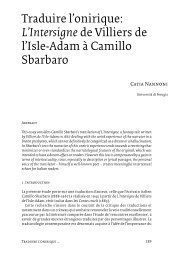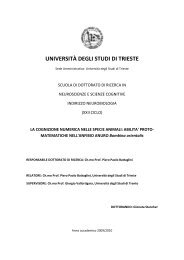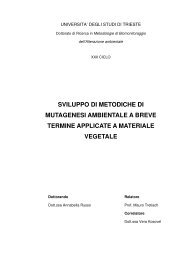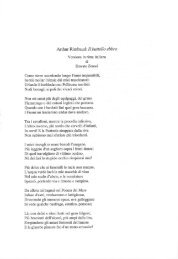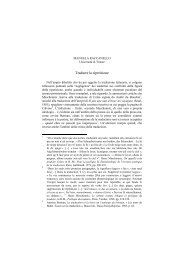Melchiorre Cesarotti e le trasformazioni del paesaggio ... - OpenstarTs
Melchiorre Cesarotti e le trasformazioni del paesaggio ... - OpenstarTs
Melchiorre Cesarotti e le trasformazioni del paesaggio ... - OpenstarTs
Create successful ePaper yourself
Turn your PDF publications into a flip-book with our unique Google optimized e-Paper software.
and civilized environment. 22 On many estates, various sublime possibilities could<br />
be accommodated within a larger and more socially directed parkscape: this could<br />
be achieved by the insertion of ‘new’ Gothic architecture [James Gibbs’ Temp<strong>le</strong> of<br />
Liberty at Stowe], or of ruins either authentic or heroically contrived [the Désert<br />
de Retz had both]; even by some representation of long-ago geological upheaval or<br />
terrifying association from literary sources, like the Cave of Polyphemus at Monza<br />
(illustrated by Silva). Self-evidently, however, the social scene was by far the more<br />
usual modality of the greatest number of landscaped estates and gardens, and the<br />
most appreciated landscapes seem to have been those – like Claude-Henri Wate<strong>le</strong>t’s<br />
Moulin Joli, as described in his own Essai – 23 where the p<strong>le</strong>asures of solitary<br />
strolling did not wholly preclude the satisfactions of social intercourse and were<br />
encouraged to cohabit seam<strong>le</strong>ssly.<br />
6. But the chal<strong>le</strong>nges for contemporary designers went beyond the adjudication<br />
of those three options in their designs. The real crux of much gardenist debate<br />
around 1800 focused on some slightly different if related topics: first and foremost,<br />
how should European designers rework the “English” landscape in both<br />
formal and associative ways for use in non-English locations – if you like, how to<br />
find local translations for any or all of the three landscapes; second, how should<br />
public grounds of all sorts be conceived, given that elite, private enclaves were<br />
no longer the so<strong>le</strong> object of designer’s work; and, third, within public grounds<br />
especially, how much effort should a designer devote to replicating landscape<br />
features that were not to be found on the given site, and were not obviously designed<br />
for the social activity that was envisaged for public open spaces.<br />
In Italy the rejection of «Englishness» was strong and vociferous, and it involved<br />
moreover, not just a refusal to imitate a «natural» landscape sty<strong>le</strong> supposedly<br />
English in origin, but an almost frenetic determination to establish Italian<br />
origins for the new landscaping sty<strong>le</strong>, so-cal<strong>le</strong>d all’ing<strong>le</strong>se. Nobody except the<br />
most staunchly patriotic Britishers like Horace Walpo<strong>le</strong> or a few outright anglophi<strong>le</strong>s<br />
in Europe thought that the landscape sty<strong>le</strong> was English by right of invention,<br />
deployment and cultural development; the French had very early objected<br />
to the English claims for the new landscaping, insisting that its origins were as<br />
much Chinese as English (hence their jardin anglo-chinois). But in Italy, with its<br />
own traditions of garden-making in the Renaissance, the rejection of the «English»<br />
mode was particularly vocal. As Mabil wrote sarcastically: «Finalmente<br />
insorgono gl’Ing<strong>le</strong>se a contrastare a tutti la palma <strong>del</strong>l’invenzione…». 24 The ex-<br />
22 These sceneries are frequently the object of illustrations, for some examp<strong>le</strong>s of which see my<br />
The Picturesque Garden in Europe, London, 2002, figures 58, 89, 103, 104, 137, 149, 155, 170, and 172.<br />
23 See C.-H. Wate<strong>le</strong>t, W Essay on Gardens. A chapter in the French picturesque, edited and translated by<br />
S. Danon, with an introduction by J. Disponzio, Phila<strong>del</strong>phia, 2003.<br />
24 All quotations, un<strong>le</strong>ss otherwise noted, are taken from<br />
All quotations, un<strong>le</strong>ss otherwise noted, are taken from L’Arte dei Giardini. Scritti teorici e pratici<br />
dal XIV al XIX secolo, II (see note 20).<br />
14


